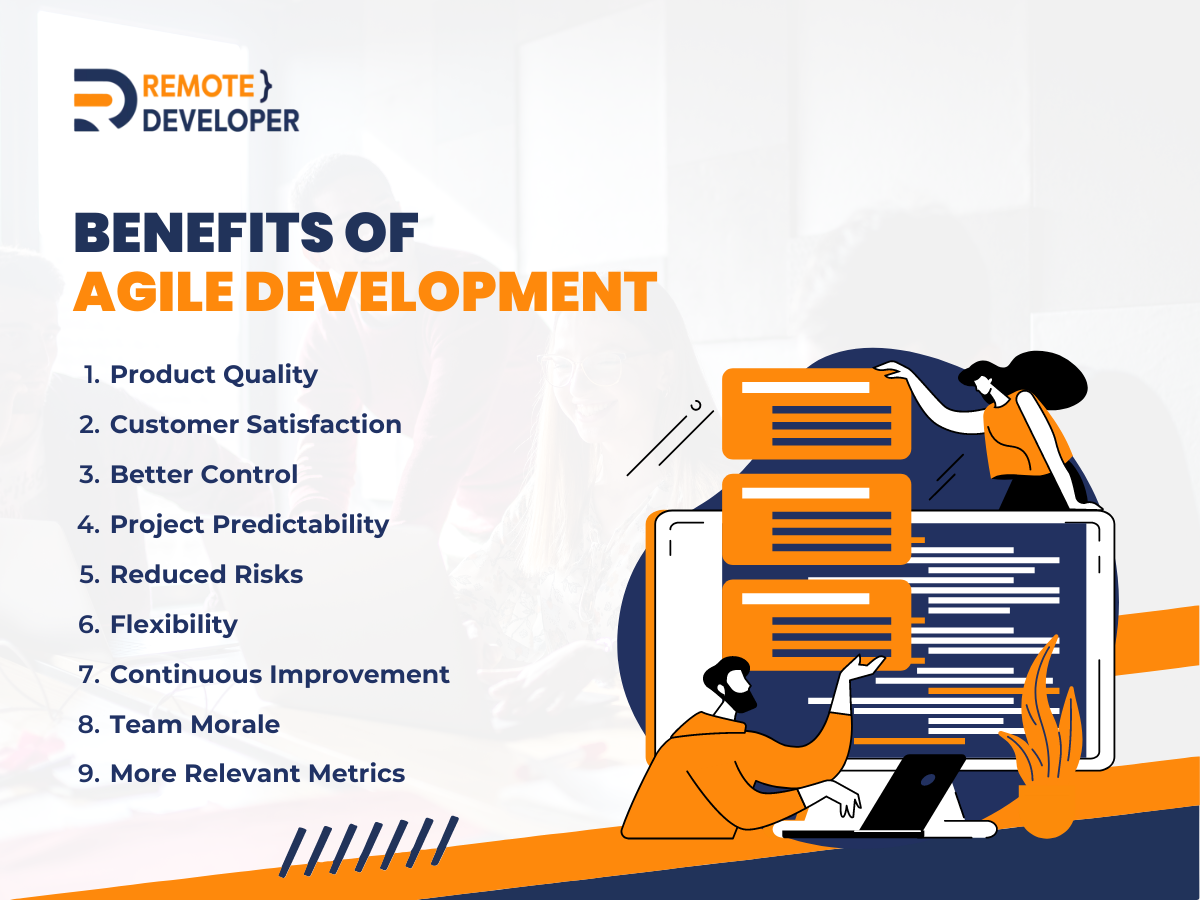In the digital era, where adaptability, collaboration, and speed are vital to success, agile development is a crucial element to achieve this. Many organisations acknowledge its importance and integrate it into their business strategy to streamline their software development cycle.
There is a good reason why agile development has been in-trend for years now. This article will explore its importance and how you can integrate it into your business for software development.
The Basics of Agile Development
What is agile methodology?
It is a project management method wherein you break down projects into smaller, manageable phases. Throughout the entire project lifecycle, there is constant collaboration and improvements based on the feedback of stakeholders and changing project requirements.
What is agile development?
While the agile methodology is the framework, agile development refers to the actual process that starts from designing, designing, coding, testing, and up to delivering the software product. The aim is for teams to be self-organised and cross-functional to effectively work together through the project cycle.
Moreover, agile development focuses on the day-to-day aspect such as sprint planning, daily stand-up meetings, sprint reviews, and retrospective meetings.
What are the principles of agile development?
There are twelve guiding principles to the agile development methodology, as stated in the Agile Manifesto:
- Our highest priority is to satisfy the customer through the early and continuous delivery of valuable software.
- Welcome changing requirements, even late in development. Agile processes harness change for the customer’s competitive advantage.
- Deliver working software frequently, from a couple of weeks to a couple of months, with a preference for a shorter timescale.
- Business people and developers must work together daily throughout the project.
- Build projects around motivated individuals. Give them the environment and support they need, and trust them to get the job done.
- The most efficient and effective method of conveying information to and within a development team is face-to-face conversation.
- Working software is the primary measure of progress.
- Agile processes promote sustainable development. The sponsors, developers, and users should be able to maintain a constant pace indefinitely.
- Continuous attention to technical excellence and good design enhances agility.
- Simplicity–the art of maximizing the amount of work not done–is essential.
- The best architectures, requirements, and designs emerge from self-organizing teams.
- At regular intervals, the team reflects on how to become more effective, then tunes and adjusts its behaviour accordingly.
What is agile software development?
In truth, agile software development is similar to agile development. It is usually used interchangeably since these essentially refer to the same day-to-day practices for agile.
However, the important thing to note is the context: Agile development is the concept while agile software development refers to its subset application. Meaning, you apply the same principles, framework, and processes specifically for software development.
What is the difference between agile software development to traditional software development?
How does agile software development differ from traditional software development?
Traditional Software Development
As the name suggests, traditional software development is the process used before, usually for designing and developing simpler software in the past. Characteristically, it is rigid, linear, and documentation-heavy at every phase of the software development cycle.
It is divided into five phases:
- Requirements Analysis
- Design
- Implementation
- Coding and Testing
- Maintenance
Traditional software development models:
- Spiral Model
- Waterfall Model
- V Model
- Incremental Model
Moreover, traditional software development is differentiated by the following features:
- Predictive approach
- Used for simple software
- Tests only once, after the development phase
- Linear structure
- Less security
- Less functionality
- Less involvement from stakeholders
- Fixed development model
- Development cost less
- Rarely used by software development firms
- Used by beginners and novice
Agile Software Development
On the other hand, agile software development is a popular and go-to approach for many developers these days and is best suited for designing and developing complicated software.
It is divided into three phases:
- Project Initiation
- Sprint Planning
- Demos
Agile software development models:
- Scrum
- Extreme Programming (XP)
- Crystal
- Dynamic Systems Development Method (DSDM)
- Feature Driven Development (FDD)
- Adaptive Software Development (ASD)
Here are the features that differentiate agile software development:
- Flexible approach
- Used for complicated and sensitive software projects
- Development and testing are performed concurrently
- Iterative structure
- High security
- More user functionality
- More involvement from stakeholders
- Changeable development model
- Used by experienced and professional developers
- Often used by software development firms
Benefits of Agile Development
There is no denying that agile development offers teams plenty of flexibility and allows for adaptive planning and quick response to feedback and possible changes. Beyond that, there are also advantages and disadvantages of agile software development.
Listed below are the benefits that your team can enjoy.
Product Quality
Agile project management integrates testing into the project execution phase. This key aspect essentially contributes to the fact that developers can ensure a higher software product quality.
Moreover, stakeholders and development teams collaborate throughout the project cycle. This makes it easier to change and adapt based on feedback, requirements, and even market realities.
Customer Satisfaction
For agile development, clients are involved in the decision-making process. This ensures customer satisfaction and even customer retention. Flexibility and proactive, collaborative aspects make it easier to produce software that clients will definitely want and use. Moreover, it significantly reduces the time from the project cycle to the market.

Better Control
Agile development provides project managers better control over a software project as enhances transparency, integrates feedback, quick adaptation, and has quality control features.
Project Predictability
One of the advantages of agile methodology is it makes projects more predictable. It enables project managers to have better visibility throughout the project cycle, allows them to mitigate risks, and predicts performance and completion.
Reduced Risks
Agile teams work in small sprints, ensuring continuous delivery, even by increments. Moreover, failure is less likely with agile development because of its flexibility and adaptability. In addition, every aspect of the project is salvageable and can be utilised one way or the other further down the line.
Flexibility
Agile teams have flexibility. They work in shorter sprints, can get feedback from stakeholders at every phase of the project cycle, and easily make the necessary revisions and changes. In addition, because projects are divided into sprints, it is not time-consuming and costly.
Continuous Improvement
Aside from being a benefit, continuous improvement is one of the key principles of agile development. Each sprint improves with every iteration, and teams learn from past mistakes and improve further.
Moreover, by nature, agile has an open culture of idea exchange and collaboration. This enables every member of the team to grow in a relaxed and supportive environment.
Team Morale
While the project manager oversees the project and acts as the middle-man, agile teams have more autonomy and authority in their decision-making process. This enables every member to work in a relaxed and self-managing environment.
In addition, agile teams are cross-functional. This presents team members to learn project management skills and further develop their skills. Moreover, frequent open discussions about project challenges create a close-knit and collaborative environment.
More Relevant Metrics
Lastly, one of the advantages of agile methodologies is the emphasis on producing results and optimising performance throughout the project cycle. This means utilising relevant metrics to get accurate data for time, costs, and the project’s performance.
Moreover, incorporating relevant metrics makes it easier for project managers to identify bottlenecks in the project and every member’s productivity, and make data-backed decisions.
Top 5 Types of Agile Methodologies
There are five popular approaches when it comes to agile development. Each one is effective and fits best for a particular project. Chances are you are already familiar with some, if not, most of them already.
Scrum
Scrum is one of the most commonly used frameworks. It has a cyclical process called sprints that typically lasts for two to four weeks.
In addition, it has a couple of ceremonies throughout the one cycle, such as daily Scrum, sprint planning, sprint review, and sprint retrospective. The aim is to facilitate communication, collaboration, and progress tracking.
Kanban
The word kanban originates from Japan, which means means “visual signal” or “card.”
With that said, a Kanban board is usually arranged into columns that represent the stages of the workflow. One of the popular Kanban tools you may already be familiar with is Trello. Its display is meant to show the flow of the software project and break it down into small tasks as a card.
Extreme Programming (XP)
XP is an Agile development framework created by Kent Beck in the late 1990s. Its approach is based on the idea of finding “the simplest thing that will work.” That means a team will not be hassled by the intricacies of long-term planning.
It involves working on small sprints with frequent releases. What differentiates it is that it emphasises testing. But it is open to changes even if these come in late during the software development cycle. This makes it a great fit for engineering projects that initially need testing.
Lean Development
Lean development originated from Lean Manufacturing. It was created by Toyota and later applied to agile software development. Its approach encourages a team to remove any activity that does not bring value to the product. It is meant to help streamline the process and deliver value to customers by the concept of the minimum viable product (MVP) and incrementally enhancing it.
Crystal
This is considered one of the most flexible Agile methodologies. It offers a team tremendous freedom and enables them to develop their processes. The focus of this approach is communication, specifically, the team’s internal interactions. In addition, it focuses on the symbiosis between the member’s roles in the project and the process, and how they come together to be more efficient.
How To Integrate Agile Development Into The Business
There are plenty of agile methodologies to choose from. However, what is important is to successfully integrate agile development into your business. For one thing, adopting its iterative and collaborative approach ensures your team can complete your software development project promptly and provide high-quality results.
Understand Agile Best Practices
The first step to incorporating it is ensuring you and your organisation understand its principles. Not surprisingly, a lot of businesses already recognise the benefits of agile development in maximizing team output and product success.
Ensure everyone in your company understands the purpose and benefit of agile development. It can reduce resistance to change, increase innovation, and make members feel more engaged in their work.
Get Stakeholder Buy-In
Aside from understanding it, everyone should also agree to adopt it. This includes key stakeholders like the project team, customers, project sponsors, and vendors. After all, collaboration and transparency are essential aspects of agile development.
Start With One Project
With that said, even though everyone is on board with adopting agile development, it is important to ease into it. Take it easy and start with just one project to focus on.
Remember, it is all about making incremental progress through iteration. You can move to apply it to other projects across the organisation once the feedback and results are positive.
Choose a Framework
There are a lot of agile frameworks to choose from. The important thing to consider is what best fits your team and your project needs. Moreover, make sure to stick with it and be consistent from start to finish to make it work.
Focus On Empowering Your Team
Next is to empower your team because every member plays a crucial role. That is why agile development underscores the importance of communication, collaboration, and problem-solving. Make sure to motivate every member, provide them with the necessary support, and trust them to deliver the results.
Retrospect and Revise
When you are in the process of implementation, it is crucial to follow a proven process first. While you are in the learning phase, make sure to avoid hybrid frameworks and changing mid-sprint. This is to avoid inconsistencies and ensure integration is successful.
However, that does not mean you have to staunchly stick to one forever. You can consider trying other agile frameworks or make changes to the one you are utilising. Moreover, hold retrospectives with your team and stakeholders to identify what works and what does not and make the necessary improvements.
Final Thoughts
Agile development revolutionised the way businesses and teams develop software in this modern era. Its iterative approach, focus on customer feedback, and emphasis on collaboration has made it a vital tool.
Furthermore, agile software development ensures the delivery of high-quality software products quickly and efficiently. The great thing about it is that it can be applied to simple or complex tech projects.
Even beyond that, agile can also be applied to other aspects of the business and other industries. It is not just a trend. Embracing agile development helps your business be more productive and efficient, and stay ahead of your competition.
Build the software of your dreams with Remote Developer! Contact us now!

